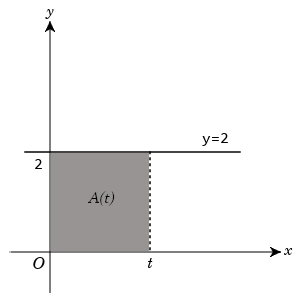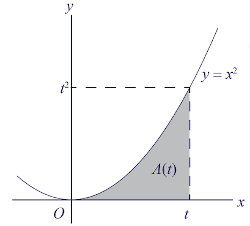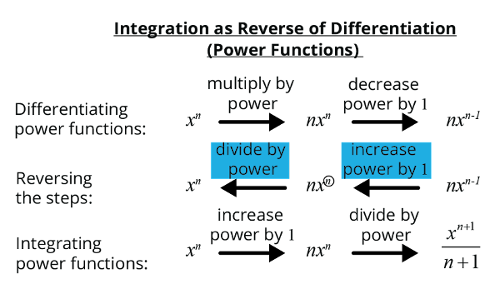Integration Techniques
In this article, we will learn about different integration techniques. We will study the following concepts:
- Introduction to Integration
- Rules of Integration
- Integration of Power Functions
Introduction To Integration
Integration in mathematics is defined as the reverse process of differentiation.
Let us look at a few scenarios where the concept of integration is needed.
Area Under A Curve
Case 1:
Let \(A(t)\) be the function that gives the area of the region bounded by the function \(y=2\), the line \(x=t\) and the positive \(x\) and \(y-axis\). Find a function for \(A(t)\).

- Consider the line \(y=2\).
- The line \(y=2\), forms a rectangle, which area is \(A(t)\).
- Since it is a rectangle, the area can be found by applying the area formula of the rectangle.
To find the area,
\(\begin{align*} A(t) &= t \times 2 \\ \\ A(t) &= 2t \;\text{units}^2 \end{align*}\)
These kinds of cases can be solved without integrating.
Case 2:
Let \(A(t)\) be the function that gives the area of the region bounded by the function \(y=2x\), the line \(x=t\) and the positive \(x\) and \(y-axes\). Find the function for \(A(t)\).

In this case, the line \(y=2x\) is inclined towards \(x\). This forms a triangle.
Therefore, to find the area of this triangle,
\(\begin{align*} A(t) &= \frac {1}{2}\times t \times 2t \\ \\ A(t) &= t^2 \end{align*}\)
These kinds of cases can also be solved without integrating.
Case 3:
Let \(A(t)\) be the function that gives the area of the region bounded by the function \(y=x^2\) , the line \(x=t\) and the positive \(x\) and \(y\)-axes. Find the function for \(A(t)\).

In this case, the curve \(y=x^2\) is actually a curve.
Here, small rectangles can be drawn to find the area, as shown below.

This is where we use integration to find the area under the curve, also known as the indefinite integral. Let us look into this concept briefly below.
The Indefinite Integral
Notations For Integration
There are two ways in which integration can be represented.
- \(\begin{align*} y=x^2 \end{align*}\)
The above equation, when integrated, it becomes,
\(\begin{align*} \int y\,dx = \int {x^2}\,dx \end{align*}\)
Where,
\(\begin{align*} \int \end{align*} \) denotes integration.
\(dx\) denotes that it is integrated with respect to \(x\).
\(y , \,x^2\) are the expressions that need to be integrated.
- \(\begin{align*} f(x) = x^2 \end{align*}\)
The above equation, when integrated, it becomes,
\(\begin{align*} F(x) = \int x^2\,dx \end{align*}\)
\(f(x)\) becomes \(F(x).\)
\(\begin{align*} \int \end{align*} \) denotes integration.
\(dx\) denotes that is integrated with respect to \(x\).
\(x^2\) is the expression that needs to be integrated.
\(F(x)\) is also known as the anti-derivative of \(f(x).\)
The term anti-derivative is the term that is used to call the result that is obtained from integrating \(f(x).\)
Comparing The Notation Of Differentiation And Integration
The difference in the notation of differentiation and integration is explained using the two cases below.
- \(\begin{align*} y=x^2 \end{align*}\)
In integration,
\( \begin{align*} \int y\,dx =\int x^2\,dx \end{align*} \)
Where,
\(\begin{align*} \int \end{align*}\) denotes integration
\(dx\) denotes that it is integrated with respect to \(x.\)
\(y , \,x^2\) are the expressions that need to be integrated.
In differentiation,
\(\begin{align*} \frac {dy}{dx}= \frac {d}{dx} \,x^2 \end{align*}\)
Where,
\(dy\) - differentiating \(y\)
\(dx\) - with respect to \(x\)
- \(\begin{align*} f(x) = x^2 \end{align*}\)
In Integration,
\(\begin{align*} F(x) = \int x^2\,dx \end{align*} \)
\(f(x)\) becomes \(F(x).\)
\(\begin{align*} \int \end{align*}\) denotes integration.
\(dx\) denotes that it is integrated with respect to \(x.\)
\(x^2\) is the expression to be differentiated.
In Differentiation,
\(\begin{align*} f'(x) = \frac {d}{dx}\,x^2 \end{align*}\)
When we differentiate \(f(x)\) it becomes \(f'(x).\)
\(dx\) - with respect to \(x\)
\(d\) - differentiating
Integration As Reverse Of Differentiation
As mentioned, integration is the reverse process of differentiation. There are certain considerations when doing integration.
Consider the following equation,
\(\begin{align} &\frac{d}{dx} \, f(x) & ----- \text{ equation (1)}\\[2ex] &\frac{d}{dx} \, \big[\,f(x) + 2\,\big] & ----- \text{ equation (2)}\\[2ex] &\frac{d}{dx} \, \big[\,f(x) - 2\,\big] & ----- \text{ equation (3)} \end{align} \)
When we differentiate it, equation (1) becomes,
\(\begin{align*} \int f'(x) \,dx \end{align*}\)
equation (2) becomes,
\(\begin{align*} \int f'(x) \,dx \end{align*}\)
equation (3) becomes,
\(\begin{align*} \int f'(x) \,dx \end{align*}\)
When we differentiate any constant it becomes 0 as seen from differentiating equation(2) and equation (3).
When we integrate the first derivative of a function, we obtain the original function. However, we cannot be certain whether the original function contained a constant term or not.
Hence, the arbitrary constant \(C\) is always added at the end, after integration.
Therefore,
\(\begin{align*} ∫ f(x) \;dx = F(x) + C \end{align*}\)
Here, \(C\) is an arbitrary constant.
Rules Of Integration
- Integration As Reverse Of Differentiation
\(\begin{align*} \int \bigg[ \frac {d}{dx}\, f(x)\bigg] \,dx = f(x) + c \end{align*}\)
Where \(c\) is an arbitrary constant.
- Scalar Multiple Rule.
\(\begin{align*} \int af(x) \;dx = a \int f(x) \;dx \end{align*} \)
Where \(a\) is a real number.
Here \(a\) is a real number, which is the coefficient that cannot be integrated.
- Addition/Subtraction Rule
\(\begin{align*} \int f(x) \mp g(x) \;dx = \int f(x) \;dx \mp \int g(x) \;dx \end{align*} \)
Here, the term before the + or – may be integrated separately from the term after the + or –.
Now that we have introduced the rules, let us implement them in the following questions.
Integration As Reverse Of Differentiation (Power Functions)
Consider the expression, \(x^n\), where \(n\) is a non-zero real number.
We are going to differentiate it, then integrate it by reversing the steps.

In the first step i.e., differentiation,
Stage 1: The coefficient is multiplied with power n.
Stage 2: The power is decreased by 1.
In the second step i.e., reversing differentiation,
Stage 1: The power is increased by 1.
Stage 2: The coefficient is divided by the power n.
In the third step i.e., integration,
Stage 1: the power is increased by 1.
Stage 2: the expression is divided by the new power.
Integration Of Power Functions
There is a formula to integrate power functions like \(x^2, \,x^6.\)
The formula is,
\(\begin{align*} \int x^n \;dx = \frac {x^{n+1}}{n+1} + c \end{align*}\)
where,
\(n ≠-1\) and \(c\) is an arbitrary constant.
Question 1:
Integrate each of the following with respect to \(x\).
\(\mathrm{A.}\;\displaystyle{x^3}\)
Solution:
\(\begin{align*} \int x^3 \;dx &= \frac {x^{(3+1)}}{3+1}+C \\ \\ \int x^3 \;dx &= \frac {x^4}{4}+C \end{align*}\)
\(\mathrm{B.}\;\displaystyle{\frac {3}{x^2 }}\)
Solution:
The denominator is converted from positive to negative indices, \(\begin{align*} \int 3x^{-2}\;dx \end{align*}\).
Applying the Scalar Multiple Rule of Integration, we take the coefficient out, \(\begin{align*} \int 3x^{-2}\;dx \end{align*}\).
Applying the integration formula for power functions,
\(\begin{align*} \int x^n \;dx &= \frac {x^{n+1}}{n+1} +C \\ \\ &= 3\bigg [\frac {x^{-1}}{-1}\bigg ] +C \end{align*}\)
Since the answer should not be written in negative powers, we leave the final answer as \(\begin{align*} - \frac {3}{x} + C. \end{align*}\)
\(\mathrm{C.}\; \displaystyle{\sqrt {2x}}\)
Solution:
Since the root is for both \(2\) and \(x\), it can also be written as \(\displaystyle{\sqrt {2} \sqrt {x} \; dx}\).
Taking the coefficient out and writing the root of \(\displaystyle{x}\) as \(\displaystyle{\frac {1}{2}}\), we have \( \displaystyle{\sqrt {2} \int x^{^{\frac {1}{2}}} \;dx. }\)
Applying the integration formula for power functions,
\(\begin{align*} \int x^n \;dx &= \frac {x^{n+1}}{n+1} +C \\ \\ &= \sqrt{2} \bigg [\frac {x^{^{{}^3/_2}}}{\small{{}^3/_2}} \bigg ] +C \end{align*}\)
Simplifying, we leave the final answer as \(\begin{align*} \frac {2\sqrt {2}}{3} \sqrt{x^3} + C. \end{align*}\)
Question 2:
Integrate \(\begin{align*} (x+2)(x-3) \end{align*}\) with respect to \(x\).
Solution:
Expanding the expression, we get,
\(\begin{align*} (x+2)(x-3) &= x^2- 3x+2x-6 \\ \\ &= x^2 -x-6 \end{align*}\)
Integrating the expression,
\(\begin{align*} \int (x^2 -x-6) \;dx \end{align*}\)
Applying the integration formula for power functions,
\(\begin{align*} \int x^n \;dx &= \frac {x^{n+1}}{n+1} +C \\ \\ \end{align*}\)
\(\begin{align*} \int x^2 - x -6\; dx &= \frac {x^{2+1}}{2+1}-\frac {x^{1+1}}{1+1}- \frac {6x^{0+1}}{0+1}+C \\ \\ &= \frac {x^{3}}{3}-\frac {x^{2}}{2}- 6x+C \end{align*}\)
Therefore the answer is,
\(\begin{align*} \frac {x^{3}}{3}-\frac {x^{2}}{2}- 6x+C \end{align*}\)
Conclusion
In this article, we went through the big idea of Integration as the reverse of Differentiation as well as some basic integration rules – Scalar Multiple Rule, Addition/Subtraction Rule – and how to integrate Power Functions of the form \(x^n\).
Keep improving! Keep learning!
| Continue Learning | |
|---|---|
| Introduction To Differentiation | Applications Of Differentiation |
| Differentiation Of Exponential And Logarithmic Functions | Integration Techniques |
| Applications Of Integration | |


 SG
SG  VN
VN 















